Assignment:
Part- 1:
Multiple Choice Questions (Enter your answers on the enclosed answer sheet)
|
Hours Open
|
Total Revenue (dollars)
|
|
1
|
$50
|
|
2
|
75
|
|
3
|
95
|
|
4
|
110
|
|
5
|
120
|
|
6
|
125
|
Lydia runs a small nail salon in the town of New Hope. She is debating whether she should extend her hours of operation. Lydia figures that her sales revenue will depend on the number of hours the nail salon is open as shown in the table above. She would have to hire a worker for those hours at a wage rate of $10 per hour.
1. Refer to Table above. What is Lydia's marginal benefit if she decides to stay open for two hours instead of one hour?
a. $25
b. $50
c. $75
d. $125
2. A restaurant sells a large soft drink at a fixed price of $1.79. A term used by economists to describe the money received from the sale of an additional large soft drink is:
a. marginal revenue
b. net benefit
c. gross earnings
d. pure profit
3. New York City Police recommended steps the bank could take to deter robberies, including the installation of plastic barriers called "bandit barriers." The police were surprised the bank did not take their advice. According to a deputy commissioner of police, "Commerce does very little of what we recommend. They've told our detectives they have no interest in ever putting in the barriers." It would seem that Commerce Bank would have a strong incentive to install "bandit barriers" to deter robberies. Why wouldn't they do it?
a. The banks probably resent any interference from the police department.
b. The banks are concerned that "bandit barriers" would send the wrong message to customers-that the bank is unsafe.
c. The banks must have weighed the cost of installing bandit barriers against the benefits and decided that they have "no interest in ever putting in the barriers."
d. The banks would rather delay installation of any theft deterring equipment in anticipation of new lower cost innovations in the security devices market.
4. How are the fundamental economic questions answered in a market economy?
a. Individuals, firms, and the government interact in markets to decide the answers to these questions.
b. Households and firms interact in markets to decide the answers to these questions.
c. The government alone decides the answers.
d. Large corporations alone decide the answers.
5. Dr. Goldfinger decides to invest in companies which he believes can "improve the productivity and efficiency" of health care services. How can Dr. Goldfinger strive to achieve this productive efficiency?
a. by investing in companies that produce goods and services at the lowest possible cost
b. by investing in companies that fairly distribute their products and services
c. by investing in companies that produce up to the point where the marginal benefit of the last unit produced is equal to the marginal cost of producing it
d. by investing in companies that produce goods and services based on consumer preferences
6. Dr. Goldfinger decides to invest in companies which he believes can "improve the productivity and efficiency" of health care services. What would Dr. Goldfinger need to do to try to achieve allocative efficiency?
a. invest in companies that produce up to the point where the marginal cost of the last unit produced is zero
b. invest in companies that produce goods and services based on consumer preferences
c. invest in companies that fairly distribute their products and services
d. invest in companies that produce goods and services at the lowest possible cost
7. Which of the following is a normative economic statement?
a. Farmers should not be allowed to grow and sell genetically-modified crops.
b. With rising home prices and falling mortgage interest rates, the amount of home foreclosures has decreased.
c. The federal government is considering increasing regulations on the use of fossil fuels to promote the use of wind power.
d. Rising corn prices have increased the price of corn-based ethanol.
8. The economic analysis of minimum wage involves both normative and positive analysis. Consider the following consequences of a minimum wage:
(a) The minimum wage law causes unemployment.
(b) Unemployment would be lower without a minimum wage law.
(c) Minimum wage laws benefit some workers and harm others.
(d) The minimum wage should be more than $7.25 per hour.
Which of the consequences above are positive statements and which are normative statements?
a. a, b, and c are positive statements and d is a normative statement
b. Only a is a positive statement, b, c and d are normative statements
c. a and c are positive statements, b and d are normative statements
d. a and b are positive statements, c and d are normative statement
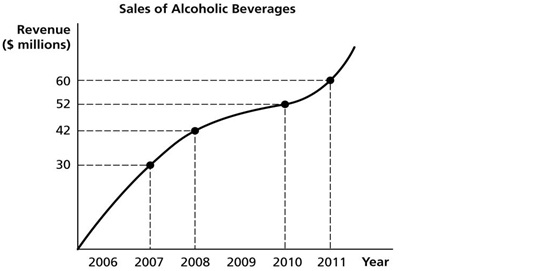
9. Refer to Figure above. Using the information in the figure above, calculate the percentage change in sales of alcoholic beverages between 2008 and 2011.
a. 23.1%
b. 23.8%
c. 30%
d. 42.9%
10. The production possibilities frontier model assumes which of the following?
a. Any level of the two products that the economy produces is currently possible.
b. The level of technology is variable.
c. The economy produces only two products.
d. Labor, capital, land and natural resources are unlimited in quantity.
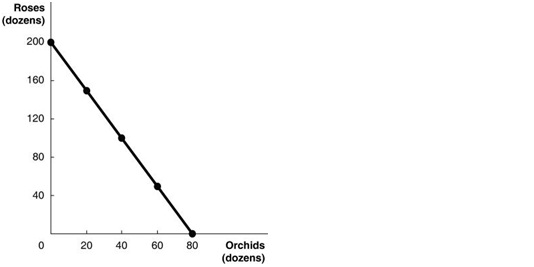
Figure above shows the production possibilities frontier for Vidalia, a nation that produces two goods, roses and orchids.
11. Refer to Figure above. If Vidalia chooses to produce 80 dozen roses, how many orchids can it produce to maximize production?
a. 24 dozen orchids
b. 48 dozen orchids
c. 60 dozen orchids
d. 74 dozen orchidsFigure shows the production possibilities frontiers for Tahiti and Bora Bora. Each country produces two goods, milk and honey
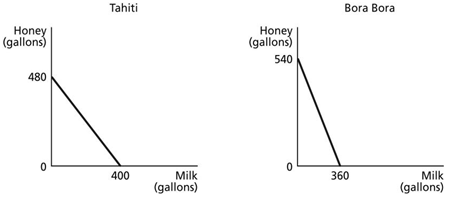
12. Refer to Figure above. What is the opportunity cost of producing one gallon of milk in Bora Bora?
a. 1.125 gallons of honey
b. 2/3 gallon of honey
c. 0.8 gallon of honey
d. 1.5 gallons of honey
|
|
George
|
Jack
|
|
Lawns Mowed
|
10
|
6
|
|
Gardens Cultivated
|
5
|
4
|
Table above shows the output per day of two gardeners, George and Jack. They can either devote their time to mowing lawns or cultivating gardens.
13. Refer to Table above. Which of the following statements is true?
a. Jack has an absolute advantage in lawn mowing and George in garden cultivating.
b. Jack has an absolute advantage in both tasks.
c. Jack has an absolute advantage in garden cultivating and George in lawn mowing.
d. George has an absolute advantage in both tasks.
|
|
One Cell Phone
|
Lumber (per board foot)
|
|
Estonia
|
40 hours
|
8 hours
|
|
Finland
|
16 hours
|
4 hours
|
Table above shows the number of labor hours required to produce a cell phone and a board foot of lumber in Estonia and Finland.
14. Refer to Table above. If the two countries specialize and trade, who should export cell phones?
a. Estonia
b. Finland
c. They should both be importing cell phones.
d. There is no basis for trade between the two countries.
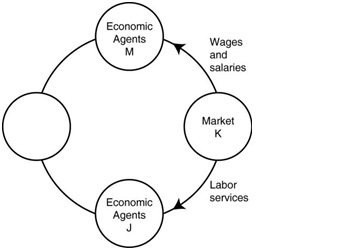
15. Refer to Figure above. One segment of the circular flow diagram in the figure shows the flow of labor services from Market K to Economic Agents J. What is Market K and who are Economic Agents J?
a. K = product markets; J = households
b. K = factor markets; J = households
c. K = product markets; J = firms
d. K = factor markets; J = firms
16. Tomas increased his consumption of potato chips when the price of pistachios increased. For Tomas, potato chips and pistachios are:
a. substitutes.
b. complements.
c. both luxury goods.
d. both inferior goods.
|
Kona Coffee Price per lb. (dollars)
|
Luke's Quantity Demanded (lb.)
|
Ravi's Quantity Demanded (lb.)
|
Rest of Market Quantity Demanded (lb.)
|
Market Quantity Demanded (lb.)
|
|
$10
|
3
|
0
|
23
|
|
|
8
|
9
|
3
|
32
|
|
|
6
|
14
|
7
|
68
|
|
|
5
|
18
|
12
|
85
|
|
|
4
|
22
|
18
|
110
|
|
17. Refer to Table above. The table above shows the demand schedules for Kona coffee of two individuals (Luke and Ravi) and the rest of the market. At a price of $6, the quantity demanded in the market would be
a. 36 lb.
b. 68 lb.
c. 89 lb.
d. 123 lb.
18. Which of the following is evidence of a shortage of walnuts?
a. The price of cashews is lowered in order to make up for the walnut shortage.
b. The quantity demanded of walnuts is greater than the quantity supplied.
c. Firms lower the price of walnuts.
d. The equilibrium price of walnuts falls due to a decrease in demand.The graph in this figure illustrates an initial competitive equilibrium in the market for apples at the intersection of D1 and S1 (point A)
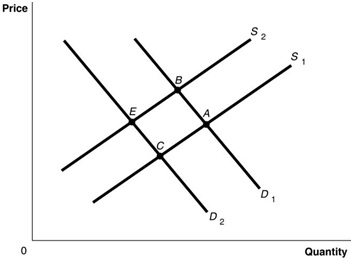
19. Refer to Figure above. If the price of oranges, a substitute for apples, decreases and the wages of apple workers increase, how will the equilibrium point change?
a. The equilibrium point will move from A to C.
b. The equilibrium point will move from A to E.
c. The equilibrium will first move from A to B, then return to A.
d. The equilibrium point will move from A to B.
20. Refer to Figure above. If there is a shortage of apples, how will the equilibrium point change?
a. The equilibrium point will move from A to C.
b. The equilibrium point will move from A to E.
c. There will be no change in the equilibrium point.
d. The equilibrium point will move from A to B.
|
Consumer
|
Willingness to Pay
|
|
Curly
|
$50
|
|
Moe
|
30
|
|
Larry
|
15
|
21. Refer to Table above. The table above lists the highest prices three consumers-Curly, Moe, and Larry-are willing to pay for a bottle of champagne. If the price of the champagne falls from
$24 to $14:
a. consumer surplus increases from $32 to $53
b. consumer surplus will increase from $80 to $95
c. Curly will buy four bottles; Moe will buy two bottles, and Larry will buy one bottle
d. Larry and Moe will receive more consumer surplus than Curly
22. The additional cost to a firm of producing one more unit of a good or service is the:
a. marginal cost
b. opportunity cost
c. total cost
d. minimum cost Figure shows the market for apartments in Springfield. Recently, the government imposed a rent ceiling of $1,000 per month.
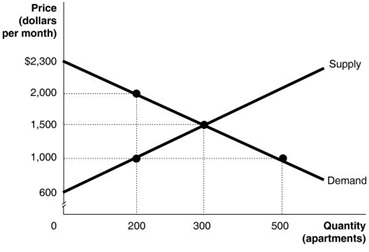
23. Refer to Figure above. What is the value of the deadweight loss after the imposition of the ceiling?
a. $50,000 b. $125,000 c. $175,000 d. $260,000
24. Congress passed the in 1996, the purpose of which was to phase out price floors and return to a free market in agriculture.
a. Farmer's Act
b. Freedom to Farm Act
c. Agribusiness Act
d. Smoot-Hawley Act
25. Economists that price controls are desirable.
a. are in agreement
b. never believe
c. only recently agree
d. are reluctant to state
Part- 2:
Multiple Choice Questions (Enter your answers on the enclosed answer sheet)
1. Of the following high-income countries, which has the highest infant mortality rate?
a. Canada
b. Japan
c. United Kingdom
d. United States
2. The health care system in is referred to as a universal health insurance system, under which every resident is required to enroll in either a private or the government-provided health insurance program.
a. Canada
b. Japan
c. United Kingdom
d. United States
3. Typically, the in a country, the higher the level of spending per person on health care.
a. larger the population
b. higher the level of income per person
c. lower the median age of the population
d. higher the level of income taxesFigure represents the market for vaccinations. Vaccinations are considered a benefit to society, and the figure shows both the marginal private benefit and the marginal social benefit from vaccination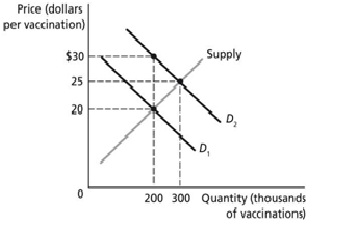
4. Refer to Figure above. The market equilibrium quantity is thousand vaccinations.
a. 100
b. 200
c. 300
d. 300
5. What is the term that describes a situation in which one party to an economic transaction has less information than the other party?
a. inefficient market hypothesis
b. unequal market structure
c. asymmetric information
d. monopsony
6. Economists refer to the actions people take after they have entered into a transaction that makes the other party to the transaction worse off as:
a. bad faith
b. economic inefficiency
c. market failure
d. moral hazardFigure represents the market for medical services with and without insurance, and the effect of a third-party payer system on the demand for medical services.
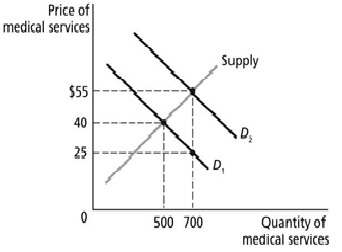
7. Refer to Figure above. The efficient quantity of medical services is:
a. 200
b. 500
c. 700
d. 700
8. Because consumers who have insurance provided by their employers usually only pay a deductible for a visit to the doctor's office, they of health care services than they would if they paid a price that better represented the true cost of providing the service.
a. demand a larger quantity
b. supply a larger quantity
c. supply a smaller quantity
d. demand a smaller quantity
9. Which of the following is not part of the "regulation of health insurance" provision of the Patient Protection and Affordable Care Act (ACA)?
a. All policies must provide coverage for dependant children up to age 26.
b. Limits on the size of deductibles and on waiting periods before coverage takes effect will be eliminated.
c. Individuals with pre-existing medical conditions will be able to acquire health insurance.
d. Lifetime dollar maximums on coverage will be prohibited.
10. Which type of business has the least government rules and regulations affecting it?
a. corporation
b. sole proprietorship
c. partnership
d. They all have the same set of rules and regulations affecting them.
11. A firm in a market economy must do all of the following to succeed except:
a. have access to sufficient funds
b. be organized as a corporation
c. produce the goods and services that consumers want at a lower cost than consumers themselves can produce
d. organize the factors of production into a functioning, efficient unit
12. What is the most common type of business?
a. corporation
b. sole proprietorship
c. partnership
d. They are equally represented because of Federal laws
13. The interest payment on a bond is called:
a. the face value
b. the interest rate
c. principal
d. the coupon payment
14. You have a bond that pays $60 per year in coupon payments. Which of the following would
result in an increase in the price of your bond?
a. Coupon payments on newly-issued bonds rise to $80 per year.
b. Coupon payments on newly-issued bonds fall to $50 per year.
c. The likelihood that the firm issuing your bond will default on debt increases.
d. The price of a share of stock in the company falls.
15. If a corporation retains all of its profits and distributes none of the profits to owners, how can owners benefit?
a. Owners will only benefit if some profits are paid out in the form of dividends.
b. If the retained earnings are expected to create future profits, the market price of the firm's stock will increase and create a capital gain for stockholders if the stock is sold.
c. Owners will benefit by changing the board of directors.
d. Shares of stock can be converted into bonds so stockholders will be able to earn coupon payments.
16. If a consumer receives 20 units of utility from consuming two candy bars, and 25 units of utility from consuming three candy bars, the marginal utility of the third candy bar is:
a. 25 utility units
b. 20 utility units
c. 5 utility units
d. unknown as more information is needed to determine the answer
17. What is the common feature displayed by the following items?
• eating in a newly opened "fusion" cuisine restaurant
• attending a Red Sox game in Fenway Park
• wearing Lucky Brand designer jeans
a. They are all highly inelastic goods.
b. The consumption of these goods takes place publicly.
c. The consumption of these goods takes place privately.
d. They tend to be consumed by better educated people.
18. Alan Krueger conducted a survey of fans at the 2001 Super Bowl who purchased tickets to the game for $325 or $400. Krueger found that (a) 94 percent of those surveyed would not have paid $3,000 for their tickets, and (b) 92 percent of those surveyed would not have sold their tickets for $3,000. These results are an example of:
a. the endowment effect
b. the failure to ignore sunk costs
c. rational consumer behavior
d. the fallacy of composition
19. Jenna runs a small boutique in Capitola. She tells one of her suppliers that she is willing to pay $6 for a pair of wool hand warmers and not a dime more. On the basis of this information, what can you conclude about her price elasticity of demand for wool hand warmers?
a. It is perfectly inelastic
b. It is perfectly elastic
c. The price elasticity coefficient is 0
d. It is elastic
|
Price per Pound (dollars)
|
Quantity of Cheese Demanded (pounds)
|
|
$16
|
3
|
|
14
|
4
|
|
12
|
5
|
|
10
|
6
|
|
8
|
7
|
|
6
|
8
|
|
4
|
9
|
|
2
|
10
|
20. Refer to Table above. Over what range of prices is the demand elastic?
a. between $2 and $8
b. between $14 and $16
c. between $8 and $16
d. over the entire range of prices
21. A firm has successfully adopted a positive technological change when:
a. it can pay its workers less yet increase its output
b. it sees an increase in worker productivity
c. it produces less pollution in its production process
d. it can produce more output using the same inputs
22. The change in a firm's total cost from producing one more unit of a good or service is the firm's:
a. marginal cost of production
b. explicit cost of production
c. average cost of production
d. implicit cost of production
23. The long-run average cost curve shows:
a. the lowest average cost of producing every level of output in the long run
b. the average cost of producing where diminishing returns are not present
c. the plant size or scale that the firm should build
d. where the most profitable level of output occurs
24. If a firm doubles all its inputs, its average cost of production increases, then production displays:
a. diseconomies of scale
b. diminishing returns
c. economies of scale
d. declining fixed costs
25. The president of Toyota's Georgetown plant was quoted as saying, "Demand for high volumes saps your energy. Over a period of time, it eroded our focus [and] thinned out the expertise and knowledge we painstakingly built up over the years." Based on this quote, what must be true of the plant's average cost of production curve?
a. It is U-shaped.
b. It is upward-sloping.
c. It is a ray from the origin.
d. It is downward-sloping.
Part- 3:
Multiple Choice Questions (Enter your answers on the enclosed answer sheet)
1. If a perfectly competitive firm raises the price it charges to consumers, which of the following is the most likely outcome?
a. The firm's total revenue will increase only if the demand for its product is elastic.
b. The firm's total revenue will increase only if the demand for its product is inelastic.
c. The firm will not sell any output.
d. The firm's revenue will not change because some consumers will refuse to pay the higher price.
2. In a perfectly competitive market the term "price taker" applies to:
a. sellers and buyers
b. buyers but not sellers
c. firms but not buyers
d. only the smallest sellers and buyers
3. Assume that price is greater than average variable cost. If a perfectly competitive seller is producing at an output where price is $11 and the marginal cost is $14.54, then to maximize profits the firm should:
a. produce a smaller level of output
b. continue producing at the current output
c. There is not enough information given to answer the question
d. produce a larger level of output
|
Quantity
|
Average Fixed Cost
|
Average Variable Cost
|
Marginal Cost
|
|
20
|
$40
|
$18
|
$18
|
|
40
|
20
|
14
|
10
|
|
60
|
13.1
|
16
|
20
|
|
80
|
10
|
22
|
40
|
|
100
|
8
|
30
|
62
|
|
120
|
6.61
|
40
|
90
|
Table shows the short-run cost data of a perfectly competitive firm. Assume that output
can only be increased in batches of 20 units.
4. Refer to Table above. If the market price is $45, the firm:
a. will suffer a loss of $200
b. will break even
c. will earn profit of $1,840
d. earn a profit of $3,600
5. Ben's Peanut Shoppe suffers a short-run loss. Ben will not choose to shut down if his business' total revenue exceeds his:
a. capital costs
b. fixed cost
c. implicit costs
d. variable costThe graphs in Figure represent the perfectly competitive market demand and supply curves for the apple industry and demand and cost curves for a typical firm in the industry.
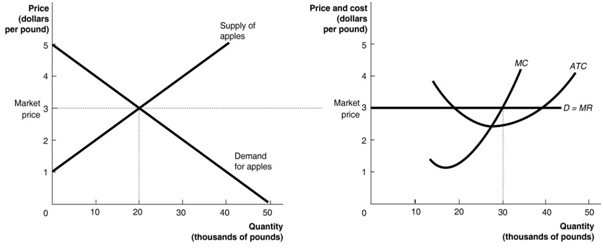
6. Refer to Figure above. The graphs depict a short run equilibrium. How will this differ from the long-run equilibrium? (Assume this is a constant-cost industry.)
a. Fewer firms will be in the market in the long run than in the short run.
b. The firm's profit will be lower in the long run than in the short run.
c. The price will be higher in the long run than in the short run.
d. The market supply curve will be further to the left in the long run than in the short run.
7. Assume that firms in a perfectly competitive market are earning economic profits. Which of the following statements describes the change in market price and output as a result of the entry of new firms into this market?
a. The short-run market supply curve shifts to the right, causing price to fall and total market output to increase.
b. The short-run market supply curve shifts to the left, causing price to rise and total market output to decrease.
c. The market demand curve shifts to the right, causing price to rise and market output to increase.
d. The market demand curve shifts to the left, causing price to fall and market output to decrease.
8. If the long-run average cost curve is U-shaped, the optimal scale of production from society's viewpoint is
a. where maximum economic profit is earned by producers.
b. one which guarantees economic profit.
c. the minimum efficient scale.
d. where firm profit is large enough to finance research and development.
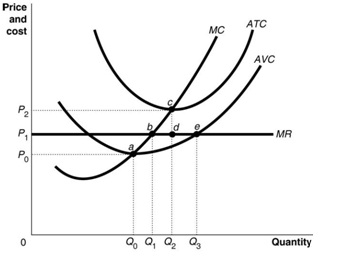
9. Refer to Figure above. If the market price is P , what is the allocatively efficient output level?
a.
b.
c.
d. There is no allocatively efficient output level because the firm is making a loss.
10. In Walnut Creek, California, there are three very popular supermarkets: Safeway, Whole Foods and Lunardi's. While Safeway remains open twenty-four hours a day, Whole Foods and Lunardi's close at 9 pm. Which of the following statements is true?
a. Safeway can ignore the pricing decisions of the other two supermarkets.
b. Safeway probably has a higher markup to compensate for its higher cost of production.
c. Safeway is a monopoly all day because it produces a service that has no close substitutes.
d. Safeway has a monopoly at midnight but not during the day.
11. Peet's Coffee and Teas produces some flavorful varieties of Peet's brand coffee. Is Peet's a monopoly?
a. Yes, Peet's is the only supplier of Peet's coffee in a market where there are high barriers to entry.
b. No, Peet's is not a monopoly because there are many branches of Peet's.
c. No, although Peet's coffee is a unique product, there are many different brands of coffee that are very close substitutes.
d. Yes, there are no substitutes to Peet's coffee.
12. What is the difference between a public franchise and a public enterprise?
a. A public franchise grants a firm the right to be the sole legal provider of a good or service. A public enterprise refers to a service that is provided directly to consumers through the government.
b. A public franchise is a firm owned by the government. A public enterprise is owned by the public through its holdings of shares of stock in the enterprise.
c. Both refer to a service provided directly to consumers through the government, but "public franchise" is a term more commonly used in the United States while "public enterprise" is more commonly used in European countries.
d. A public franchise refers to a service that is provided directly to consumers through the government. A public enterprise grants a firm the right to be the sole legal provider of a good or service.
13. When the government makes a firm the exclusive legal provider of a good or service, it grants the firm a:
a. network externality
b. public franchise
c. quota
d. copyright
14. Compared to perfect competition, the consumer surplus in a monopoly is:
a. unchanged because price and output are the same
b. eliminated
c. higher because price is higher and output is the same
d. lower because price is higher and output is lower
15. The Sherman Act prohibited:
a. collusive price agreements among rival sellers
b. selling below average total cost
c. marginal cost pricing
d. setting price above marginal cost
16. If the demand curve for a firm is downward-sloping, its marginal revenue curve:
a. is horizontal
b. will lie below the demand curve
c. will lie above the demand curve
d. is the same as the demand curve
17. Monopolistic competition is a market structure in which:
a. barriers to entry are low
b. firms cannot influence the market price
c. the demand curve for a typical firm is horizontal
d. firms produce and sell products for which there are no close substitutes
18. A monopolistically competitive firm maximizes profit in the short run by producing where price is:
a. greater than marginal cost
b. less than marginal revenue
c. less than average revenue
d. less than marginal costFigure 11-7 shows short-run cost and demand curves for a monopolistically competitive firm in the footwear market.
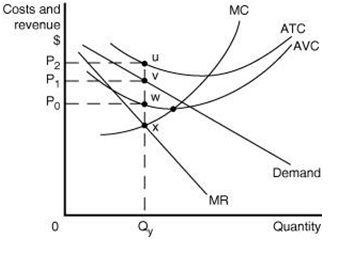
19. Refer to Figure above. Which of the following statements describes the best course of action for the firm depicted in the diagram?
a. The firm should minimize its losses by producing Qy units and charging a price of P1.
b. The firm should minimize its losses by producing Qy units and charging a price of P2.
c. The firm should exit the industry because its price is less than its average total cost.
d. The firm should minimize its losses by producing Qy units and charging a price of P0.
20. Which of the following is not a characteristic of a monopolistically competitive firm in long-run equilibrium?
a. Price is equal to marginal cost.
b. Marginal revenue is equal to marginal cost.
c. The firm has excess capacity.
d. Price is equal to average revenue.
21. An example of business fixed investment spending is:
a. a purchase of a bond by General Electric Corporation
b. $200 million of unsold cars at a car dealership
c. a purchase of a home by a household
d. a purchase of a computer by an accounting firm
22. "Household production" refers to:
a. goods and services people produce for themselves
b. home-based craft businesses
c. the home building sector of the economy
d. the manufacturing of durable household products
23. If the GDP deflator is 142, by how much have prices changed since the base year?
a. increased by 142%
b. decreased by 4.2%
c. increased by 42%
d. increased by 58%
24. Under what circumstances would the GDP deflator be less than 100 after the base year?
a. The GDP deflator will be less than 100 if there has been deflation relative to the base year.
b. The GDP deflator will be less than 100 if there has been inflation of less than 2% per year relative to the base year.
c. There are no circumstances under which the GDP deflator could be less than 100?
d. The GDP deflator will be less than 100 if there has been inflation relative to the base year.
25. The value of what a U.S.-owned McDonald's produces in South Korea is included in the U.S.
and the South Korean .
a. GDP; GDP
b. GDP; GNP
c. GNP; GNP
d. GNP; GDP
|
Total population
|
20,000
|
|
Working-age population
|
15,000
|
|
Employment
|
1,000
|
|
Unemployment
|
100
|
Part- 4:
Consider the data above for a simple economy.
1. Refer to Table above. The labor force participation rate for this simple economy equals:
a. (1,100/15,000) × 100 b. (1,100/20,000) × 100 c. (1,000/15,000) × 100 d. (1,000/1,100) × 100
2. In the modern U.S. economy, the typical unemployed person stays unemployed for:
a. a relatively short time, less than six months
b. an amount of time that is hard to quantify
c. for a long time during expansions and short time during recessions
d. a relatively long time, over a year
3. Most of the unemployment that occurred during the Great Depression was unemployment.
a. frictional
b. core
c. cyclical
d. structural
4. Which of the following is an example of a worker experiencing frictional unemployment?
a. An employee is laid off because the economy is suffering a recession.
b. A United Airlines pilot loses her job because of lack of demand for air travel.
c. A computer programmer loses her job because it is outsourced to India.
d. A worker quits his job at the post office to find more interesting work.
5. An increase in cyclical unemployment will result in:
a. an increase in the unemployment rate
b. an increase in the natural rate of unemployment
c. an increase in structural unemployment
d. a decrease in frictional unemployment
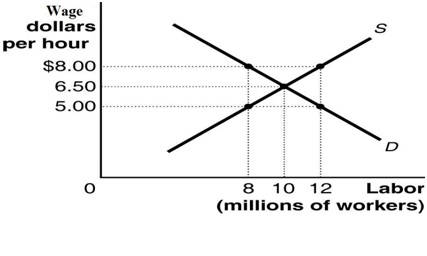
6. Refer to Figure above. Based on the graph of the labor market above, if a minimum wage is set at $5 per hour, which of the following will occur?
a. The level of unemployment will rise, but the percentage of the labor force unemployed will not change.
b. The unemployment rate will rise.
c. The unemployment rate will fall.
d. None of the above will occur.
|
Year
|
CPI
(1982-1984 =100)
|
|
2012
|
100
|
|
2013
|
113
|
7. Refer to Table above. Suppose that the data in the table above reflects the price levels in the economy. Given that data, we can say that the cost of living rose by between 2012 and 2013?
a. 2%
b. 5%
c. 8%
d. 11%
e. 13%
8. The base period for CPI calculations is generally 1982-84. In 2005, 50% of households accessed the Internet through a broadband connection that would not have existed in the 1980s. This potential for bias in the CPI is referred to as bias and results in
a. new product; the CPI overestimating the true change in the cost of living
b. net product; the CPI underestimating the true change in the cost of living
c. outlet bias; the CPI overestimating the true change in the cost of living
d. outlet bias; the CPI underestimating the true change in the cost of living
|
Year
|
Nominal Average Hourly Earnings
|
CPI
(1982-1984 =100)
|
|
2011
|
$10
|
100
|
|
2012
|
10
|
105
|
|
2013
|
12
|
110
|
9. Refer to Table above. Looking at the table above, real wages from 2011 to 2012, and real wages from 2012 to 2013.
a. fell; rose
b. fell; fell
c. rose; rose
d. rose; fell
10. The real rate of interest is the .
a. nominal interest rate minus the inflation rate
b. nominal interest rate
c. nominal interest rate plus the inflation rate
d. interest rate determined by the supply and demand in the money market
11. Which of the following individuals would be most negatively affected by anticipated inflation?
a. a retired railroad engineer who receives a fixed income payment every month
b. a union contractor whose pay is adjusted based on changes in the CPI
c. a student who borrows $10,000 at a nominal interest rate of 5% to finance educational expenses
d. a full-time employee at a pizza parlor who makes more than the minimum wage
12. If real GDP per capita doubles between 2005 and 2020, what is the average annual growth rate of real GDP per capita?
a. 4.7%
b. 10.5%
c. 15%
d. 21%
13. If the growth rate of real GDP rises from 3% to 4% per year, then the number of years required to double real GDP will decrease from years to years.
a. 23.3; 20.6
b. 11.2; 10.8
c. 23.3; 17.5
d. 28.0; 21.0
14. Which of the following will increase investment spending in the economy, holding everything else constant?
a. an increase in the budget deficit
b. an increase in transfer payments
c. an increase in the federal government surplus
d. an increase in consumer dissavings
15. An increase in the demand for loanable funds will occur if there is:
a. a decrease in the real interest rate.
b. an increase in the real interest rate.
c. an increase in expected profits from firm investment projects.
d. an increase in the nominal interest rate accompanied by an equal increase in inflation.
16. As the economy nears the end of a recession, which of the following do we typically see?
a. increased spending on capital goods by firms
b. increasing interest rates
c. further decreases in consumer spending
d. all of the above
17. A recession begins with a(n) in spending by firms on capital goods and a(n) in spending on durable goods by households.
a. increase; increase
b. increase; decrease
c. decrease; increase
d. decrease; decrease
18. Inflation is measured:
a. as the percentage change in the consumer price index
b. using the level of the consumer price index
c. using the level of real GDP
d. as the percentage change in real GDP
19. If you spend more of your income on consumption goods, which of the following will occur?
a. The production of investment goods will fall.
b. Investments in education will rise.
c. For every dollar you spend on consumption, real GDP will fall by a dollar.
d. Economic growth will be stimulated.
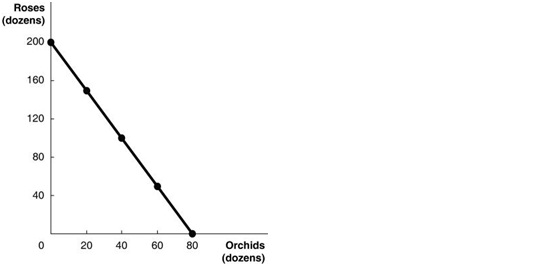
20. Refer to Figure above. Ceteris paribus, a decrease in personal income taxes would be represented by a movement from:
a. AD1 to AD2
b. AD2 to AD1
c. point A to point B
d. point B to point A
21. If stricter immigration laws are imposed and many foreign workers in the United States are forced to go back to their home countries, what would be the effect on the long-run aggregate supply curve?
a. The long-run aggregate supply curve will shift to the left.
b. We will move down along the long-run aggregate supply curve.
c. The long-run aggregate supply curve will shift to the right.
d. We will move up along the long-run aggregate supply curve.
22. If potential GDP is equal to $600 billion, what does the long-run aggregate supply curve look like?
a. It is a vertical line at a level of GDP above $600 billion.
b. It is a horizontal line at $600 billion of GDP.
c. It is a vertical line at $600 billion of GDP.
d. It is a vertical line at a level of GDP below $600 billion.
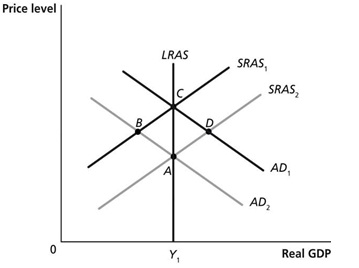
23. Refer to Figure above. Suppose the economy is at point A. If the economy experiences a supply shock, where will the eventual short-run equilibrium be?
a. A
b. B
c. C
d. D
24. Which of the following is considered a negative supply shock?
a. a decline in wages
b. increasing investment in the economy causes the capital stock to rise
c. an unexpected increase in the price of natural gas
d. an improvement in technology
25. The new Keynesians emphasize the importance of:
a. the monetary growth rule
b. rational expectations
c. sticky wages and prices
d. real causes of the business cycle